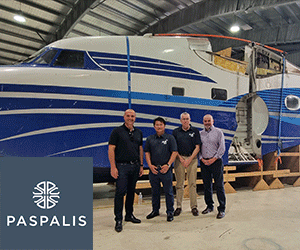1MG FlippingBooks
Connecting the dots for renewables
There is tremendous responsibility that comes with operating and managing the largest high voltage transmission electricity network in Australia, covering NSW and Canberra. TransGrid is moving beyond that mandate, transforming the nature of how Australia keeps the lights on in a carbon-constrained world.

Three million homes, businesses and communities directly rely on TransGrid to deliver safe, reliable and affordable electricity supply every day. Its network is at the heart of the National Energy Market that supplies nine million customers across the country. Transmission networks are at the forefront of Australia’s energy transformation, the backbone of the power system. It is no small feat to transport large volumes of electricity from generators to regions where it’s used, managing stability, balancing supply and demand, and facilitating competition between generators.
The decisions made this decade are critically important in preparing NSW’s power system as it transitions to a greater reliance on low-cost renewable generation such as wind and solar, and increased demand driven by population growth and technology.
As consumers get used to the idea of electric vehicle highways and smart infrastructure connecting our communities – TransGrid is strategically planning and investing, working in collaboration across the energy supply chain and implementing new projects that will shape the future grid.
TransGrid CEO Paul Italiano explains, “The road ahead is exciting. It’s all about innovation and keeping the customer at the centre of everything we do. We are transforming the way we work, leveraging emerging technologies, designing solutions for unique challenges and championing research and development.”
This involves collaborating with external partners on key projects, including several major network interconnector upgrade projects to put downward pressure on energy bills and facilitate the investment in and incorporation of more renewables. These projects will be critical in reducing downstream congestion on the network, increasing system stability and competition in the wholesale electricity market. As it manages the transition of the electricity system, TransGrid is navigating through some breakthrough initiatives that will improve its understanding of how the grid and new technologies can support new generation and demand.
NSW’s first Renewable Energy Zone
NSW’s electricity system was designed around coal-fired power stations predominantly in eastern, regional NSW where the coal was mined – with high voltage transmission networks that linked generators to population centres along the east coast. For new sources of electricity generation such as wind and solar, the most accessible and productive locations in regional NSW are mostly inland. This necessitates new planning and investment in transmission infrastructure to connect large-scale renewable generation with population centres and industry.
TransGrid is a key partner working with the NSW Government on the development of the CentralWest Orana Renewable Energy Zone (REZ) – which is expected to create 3 gigawatts of new generation capacity, enough to power 1.4 million homes and up to $5.2bn in private investment into the region to 2030. Working with the government, communities and industry, it will be able to design transmission infrastructure that provides the best opportunities for scale-efficient generator connections within the REZ. This new approach is an exciting step forward as we work towards lowering costs to meet the reliability standard for NSW and market dispatch costs, therefore putting downward pressure on prices for customers.
Piloting emerging battery technology
It is widely accepted that batteries will be key to the creation, transport and use of electricity in the future. Many Australians are familiar with the idea that large-scale batteries can provide electricity when the wind doesn’t blow or the sun doesn’t shine – what the experts call dispatchable energy. However, a new emerging area in battery technology is how it can be used to solve inertia and frequency challenges on the grid. This will be a key challenge as more wind and solar joins the grid and coal-fired generators retire. At the moment, there are very few batteries in the world designed with this as a primary purpose – and they are an attractive option for providing synthetic inertia as they are a fraction of the cost of the next best solution, a synchronous condenser.
TransGrid is taking the lead in piloting these network services through a $61.9m Wallgrove Grid Battery project that will install a 50 MW battery, the equivalent of 125,000 solar panels, at its Wallgrove substation in Western Sydney. Having received funding by the Australian Renewable Energy Agency (ARENA) as part of its Advancing Renewables Program and NSW Government as part of its Emerging Energy Program, the WGB project will be the first large-scale grid battery in NSW.
Additionally, the NSW regional centre of Broken Hill is set to become one of the world’s largest mini grids supplied by solar, wind and grid-scale storage. This follows TransGrid’s recommendation earlier this year for a new back-up supply arrangement that could see the homes and businesses of Broken Hill’s 17,000-strong population powered by renewables. In the coming years, TransGrid will learn more about how the battery can be used to respond to a frequency event, and how often it is needed to provide synthetic inertia and fast frequency response services, while setting up opportunities for future grid battery investment.
Supporting electrification of transport and industry
Electricity is already widely used to power trains and light rail in NSW. Electric and hybrid passenger vehicles are continuing to grow in popularity, with fast-charging electric vehicle infrastructure being rolled out across the nation. Transport and industrial operators are also looking at ways to decarbonise operations and invest in electric solutions.
Globally, almost 50 percent of new bus purchases are now electric. NSW and ACT governments have already committed to electrifying their entire public bus fleets – some 5,000 buses in total. Italiano notes, “Our focus is on working with industry to understand the implications of electrification on the grid and exploring opportunities to accelerate the electrification of transport by designing integrated solutions supported by transmission networks”.
Driving outcomes for customers
TransGrid is not alone on Australia’s energy transformation journey. Governments, regulators and industry are all working together, with roadmaps and strategies in place – and widespread recognition across the energy supply chain about the role networks, generators and retailers play in driving better outcomes for customers. This is evidenced by the Energy Charter, an industry-led initiative with TransGrid as a founding signatory, which is focused on better addressing customer expectations.
Italiano explains, “As we look to the future as an organisation, our path is clear. We must continue to be at the forefront of innovation and technology, develop our understanding of future grid requirements, ensure that every investment in the power system is rigorously assessed and demonstrate benefits to energy customers.”










